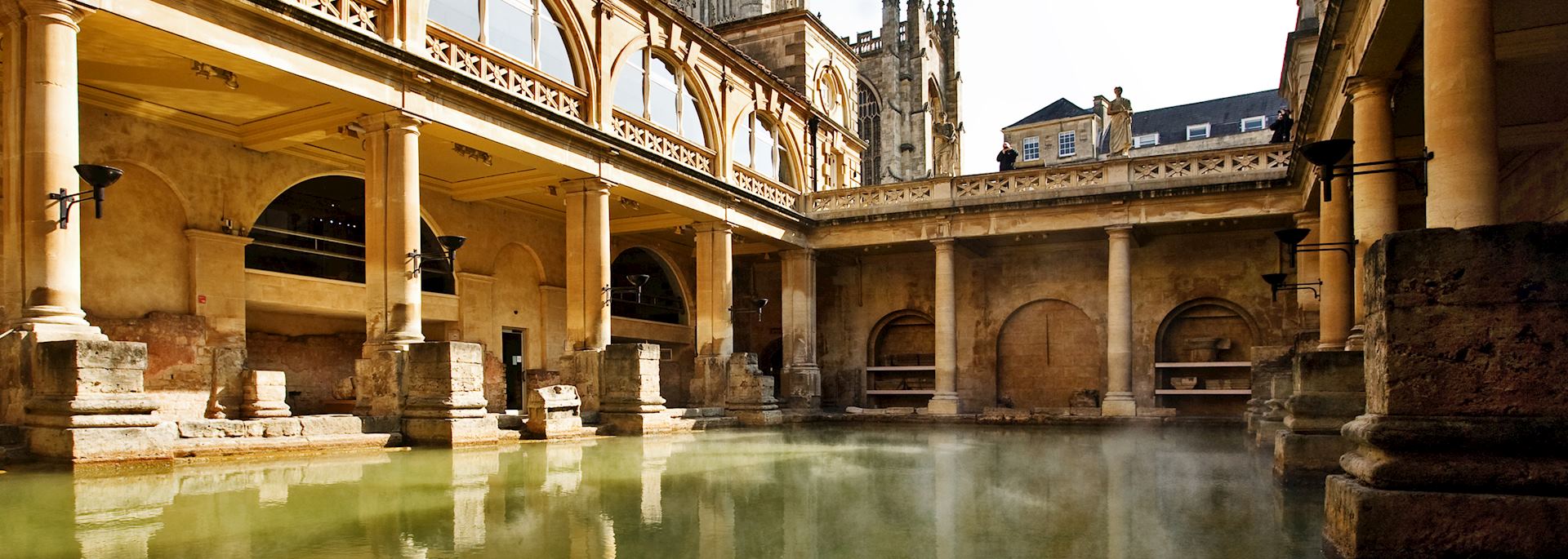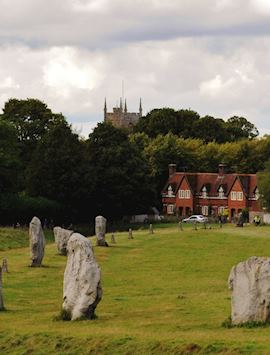By Katie from our UK and Ireland team
Though Stonehenge is the best-known and most popular prehistoric site in the British Isles, it’s far from the only one.
There are more than 500 stone circles in Scotland alone, and Ireland has so many that they deserve a separate article. There are also remnants of the Roman occupation, including in England the Roman Baths in the south and Hadrian’s Wall to the north. Here, I suggest both Scottish and English ancient attractions, which are convenient to major destinations like Bath or the Lake District, so you can easily incorporate them into your trip.
Stonehenge, Wiltshire, England

Stonehenge is emblematic of Britain, much as the Eiffel Tower says France, or the Colosseum Italy. Whenever Britain votes on its best views or greatest wonders, Stonehenge is sure to be on the winners’ list. It’s an unsolvable puzzle that archaeologists love to try to unravel.
Stonehenge earns its reputation and absolutely you should visit. Be aware though, faced with such hype, it can be a tiny bit anticlimactic. First, a major highway runs near the site, creating a continuous thrum of traffic noise. The road is often clogged with tourists and rubberneckers, lingering to catch a view of the well-known silhouette.
Second, you can’t get close to the stones. A wide perimeter rope keeps all visitors at a safe distance, unless it’s a special occasion like the summer or winter solstice, when pagans from far and wide mob the site (and bring the road to a standstill for days).
Despite all this, it’s still a vital destination. The size of the hulking sarsen stones that make up the outer ring reach up to three times a man’s height — you have to travel to Scotland’s Orkney Islands to see other stones as big. And, it’s the only stone circle I know of where lintels still cap some of the uprights.
There’s also the matter of its enormous age — some of the oldest parts might date back as far as 3,000 BC — as well as the enduring mystery of the site. Why did the ancients pour so much effort into this construction? Experts estimate that the circles took about 30,000,000 man-hours to build. How did they transport the Brobdingnagian slabs from as far away as Wales? Who are the people whose bodies were interred here?
The adjacent Visitor Centre offers a comprehensive exploration of these issues and more, along with items found on site and a facial reconstruction of a Neolithic man. There are also replica Neolithic houses, where you can see recreated tools based on finds at the site as well as demonstrations of period techniques.
If you visit during haying season, you may see the surrounding fields dotted with makeshift henges constructed from bales of hay.
Stonehenge is just two hours from London and an hour from Bath, making it easy to visit from either city. We offer a private tour with a driver-guide to Stonehenge, nearby Avebury and the village of Lacock (the birthplace of photography).
Avebury, Wiltshire, England

The village of Avebury and its surrounding farmland is the locus of three Neolithic sites that are, to me, even more impressive than Stonehenge.
A stone circle almost encloses the village in a vast ring, the largest megalith circle in Europe, with two smaller circles inside it. The stones are smaller and less uniform than Stonehenge’s carefully hewn blocks, but many still loom much higher than a tall man. What’s more, you can actually touch the stones — there are no ropes or crowds to keep you away.
I suggest walking the circumference of the ring. You tramp through grassy, sometimes muddy fields, but it gives an excellent sense of the sheer scale of the site. A 30 ft (9 m) ditch drops down from the left of the path, which predates the stones.
Avebury is by no means undiscovered, but for the most part your company will be local visitors, who look upon the village as a pleasant diversion, plus a few grazing sheep. As with Stonehenge, the numbers swell during the summer solstice.
By and large, Britain’s stone circles stand in wild places: moorland, farmland or plain. But, a large part of Avebury’s personality comes from the village that grew up around the ancient monument, and you can reserve a good hour or two to visit its Saxon stone church, Tudor manor house and gardens, and stop off at the Red Lion inn. During the summer, the thwack of a cricket ball being struck adds to the very English ambience, when Avebury Cricket Club plays local rivals within striking distance of the stones.

A short walk south through yet more fields brings you to the West Kennet Long Barrow. Dating from 3,650 BC, it’s a long, narrow tomb made of huge stones and covered in grassy earth. You can climb on the massive grassy hill and run your hands over the boulders, peering through the cracks to see where more than 50 individuals were found buried. You can also go inside and see the side chambers where the dead were laid out.
As big as the barrow is, it’s a mere mole hill compared with the monumental Silbury Hill. Just north of the village, this is the largest man-made mound in Europe, similar in size and age to some of the Egyptian pyramids. It’s newer than the other sites, a relative baby created at about 2,500 BC. It’s simply a giant hulking mound, rising up from the turf, containing no burials or any hints to its purpose — experts are perplexed. In order to protect the site, you can’t climb on the hill, merely admire its towering bulk from afar.
Until the 1930s, Avebury’s megaliths mostly lay flat on the ground, toppled by the passage of more than four millennia. Then in 1934 Scottish marmalade millionaire and keen archaeologist Alexander Keiller bought the village and set about the task of re-erecting the stones. A museum in the village named after him explores the site and displays items found during digs.
Roman Baths, Bath, England

Not far from Stonehenge and Avebury is Bath, a city that dates back to the Romans. Since then (and probably even before), people have come here to soak in the steaming mineral waters that give Bath its name. When the Romans settled, they made the thermal springs a sacred site of the goddess Minerva Sulis, a mash up of their own goddess and a Celtic deity Sul.
Their settlement wasn’t a garrison but a hub of recreation, where locals would visit to catch up on the gossip while making their daily ablutions. These included bathing, resting in a sauna, having their hair dressed and getting their armpit hairs plucked in an alcove dedicated to that purpose.
Of the Roman Baths themselves, just the pool remains. It’s a large rectangular structure, filled with eerie green water. (The startling shade comes from algae that thrives in the warm, mineral-rich waters.) The surrounding building dates to the Georgian era, when the city became a fashionable spa.
Because the baths are such a popular attraction, I suggest visiting early in the morning, before the crowds arrive, to explore thoroughly. But I also like to return in the evening. The site is open late and it’s a treat to see warm green water lit by spotlights, mist coiling up into the cool night air. A private guide can help you understand the site’s long history, from its Roman founding, to its Georgian heyday through modern archaeological excavations.
You can’t swim in the original Roman Bath, but at the nearby Thermae Bath Spa, you can ‘take the waters’ in a modern spa that’s fed by the same spring. (Bring a swimsuit; children under 16 aren’t permitted.)
There’s also a museum that gives historical context for the site, including a display of some locally excavated curse tablets. These carved clay tablets were offered to Minerva Sulis, beseeching her to take revenge on miscreants, most often thieves. Some are exceptionally bloodthirsty, begging the goddess to take the minds and eyes of thieves or to eat their intestines.
Standing stones at Castlerigg, Cumbria, England

The stone circle at Castlerigg is less monumental than its more southerly sisters, a smaller circle (only about 30 m or 7 ft) comprised of smaller and much less uniform boulders. But it dates back to the Neolithic era, about 3,000 BC, which could make it the oldest circle in Britain. And, strictly speaking, it’s an oval, which singles it out from Britain’s other stone circles.
There are no information boards here, nor a museum. Simply a circle of stones sitting in a grassy field. Few visit, so you can usually wander through in quiet solitude.
As with many of the prehistoric sites, experts are unsure as to the precise significance of the circle. It was likely a meeting place, though whether for religious or trading purposes, they don’t know. Some speculate that the size, shape and orientation of the stones might correspond with the surrounding mountains, making it a primitive map of the area.
And, admiring the surrounding region is one of the main reasons to visit Castlerigg, I’d say. This is just one stop on a driving tour of the Lake District, a region that has captivated visitors since before Wordsworth captured the landscape in verse. The circle stands in a high clearing ringed by gentle mountains that roll into the distance. From here, you can barely make out distant villages, their white buildings reduced to mere specks against the far green fields
Hadrian’s Wall, Northumberland, England


Once a vast and imposing barrier studded with forts, Hadrian’s Wall originally marked the far northern edge of the Roman Empire. It spans the narrow neck of the island coast to coast, a distance of 135 km (84 miles). Today, the mighty landmark is much reduced, but it’s still a visceral reminder of the might and limitations of the Romans.
For the dedicated walker, a path follows the route of the wall, but it takes almost a week to traverse entirely. Instead, I suggest asking your driver-guide to stop at one of the wall’s best-preserved sections in Northumberland, a convenient pit stop if you’re driving north from England to Scotland.
Here, parts of the wall are still square and strong, though patchworked with green moss. The remnants of a ruined fort sketch regular rectangles in the hummocks of grass, the once-mighty stronghold reduced to foundations.
From the wall, the land to the north drops precipitously (the side occupied by the allegedly barbaric Picts). From the ridgeline, you have a long view of the wild sweep of rugged hills. Last time I was there, dark, angry clouds loomed threateningly overhead, adding a foreboding backdrop to the windswept, untamed land.
There’s a small museum nearby, but I prefer to visit Vindolanda. Just a 10-minute drive from the wall, it’s a much bigger Roman fort with a more extensive museum. Because it’s an active archaeological site, you can sometimes watch the excavations. The displays spotlight items found on the dig, including soldiers’ letters to each other or home, carved on tablets. It gives you an impression of what life must have been like 1,800 years ago for a young Roman soldier stationed so far from home.
Clava Cairns, Inverness, Scotland

These Bronze Age burial cairns (stone mounds) have enjoyed a surge in popularity thanks to their role in the time-travel costume drama Outlander. The site stood in for Craigh na Dun — the portal that transports Claire through time.
More than 4,000 years old, the site has two discrete parts. The most complete section, located in peaceful woodland, is called Balnuaran of Clava and consists of three tombs, each surrounded by a ring of stones.
The cairns are low and unimposing but hefty — piles of smallish rocks buttressed by larger boulders. Two are passage graves with a long, narrow passageway leading into the now-empty burial chamber, and one is a kerb tomb where the chamber is completely enclosed.
The builders’ interest in the winter solstice is apparent in the positioning of the tombs and standing stones, which all align with the sunset on the shortest day of the year.
The nearby Milton of Clava is barely of interest, with just the remains of a cairn and a few possible standing stones, as well as the ruins of a medieval chapel.
Visiting Clava Cairns can be one stop on a driving tour of interest to any aficionados of Outlander or Scottish history. The private tour also includes a visit to Culloden Moor, the battle site where the Jacobite Rebellion was finally and irretrievably crushed.
Arthur’s Seat, Edinburgh, Scotland

Holyrood Park is a striking anomaly — a patch of unmanicured wilderness in the middle of a country’s capital. The park is dominated by a worn basalt hill named Arthur’s Seat, all that remains of a long-extinct volcano. A hike to the peak is one of the literal highlights of a visit to Edinburgh.
Much mythology swirls around the slopes of Arthur’s Seat. On May Day, local lasses use to wash their face in the morning dew at the peak, a pagan ritual from the era of the druids said to bring vitality, beauty and good fortune for the rest of the year. As indicated by its evocative name, the Seat is also one of the possible locations of Camelot.
On the east side of the knoll, you can find the bare remains of two Iron Age forts. The ruins are, honestly, nothing much to look at — some stones erupting from the thin grass and ridges in the earth that are, the experts say, Bronze Age terracing. But the long views here are more than worth the 45-minute climb. On a clear day, you can see all of the Royal Mile, from Holyrood Palace to Edinburgh Castle, and beyond to the distant Highlands in the north and to the Forth Bridges in the west.
Read more about trips to the UK
Start thinking about your experience. These itineraries are simply suggestions for how you could enjoy some of the same experiences as our specialists. They're just for inspiration, because your trip will be created around your particular tastes.
View All Tours in England


